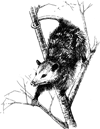Vertebrate Pest Conference: Proceedings

Vertebrate Pest Conference Proceedings: 16th (1994)
Date of this Version
February 1994
Document Type
Article
Abstract
Information on breeding aspects of rodents is important to ensure control program timing necessary for effective pest management. Hence, studies on breeding aspects of the brown spiny field mouse (Mus platythrix), a known rodent pest in dry land crops were investigated including environmental factors influencing reproduction, from regular monthly collections made during the years 1990 and 1991. Field trapped rodents were classified to derive their population structure—percent juvenile, pre-pubertal and adult including prevalence of pregnancy—based on body weights and sexual conditions. The stage of pregnancy and sperm motility were confirmed by autopsy studies. The data were also analyzed to calculate the annual breeding productivity. The results indicate that the brown spiny field mouse experiences a seasonal reproductive cycle of active breeding during the period June to February followed by sexual quiescence during the period March to May. The peak reproductive activity seen during September (55%), October (79%) and November (62%) coincides with peak abundance of heavier males and females in the population. A litter size of two (during June) to eight (during October) also coincides with peak prevalence of pregnancy. The adult male to female ratio is 1.0:1.1, respectively. The annual breeding productivity is calculated M be 54 young/female/breeding season. Further prevalence of rainfall, low temperature, short day length, and higher relative humidity seen during July onwards promoting green vegetation are conducive to reproduction. Hence, it is inferred that the period March to May is suitable for timing the rodent control programs in dry land crops against the brown spiny field mouse, when the field population is at base considering the cost-benefit ratio and operational aspects.

